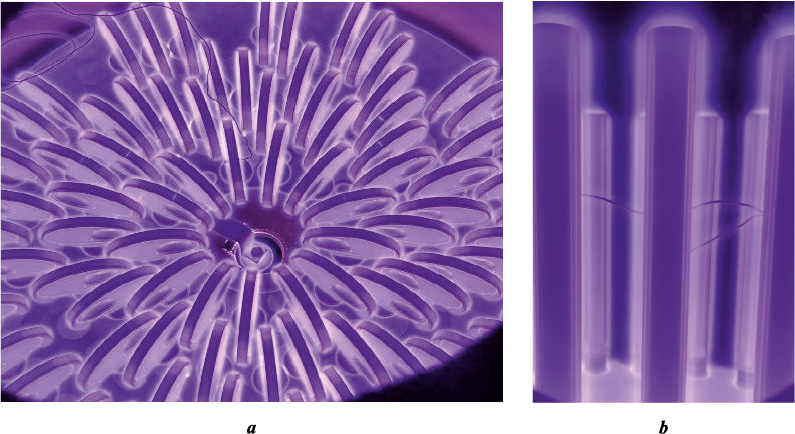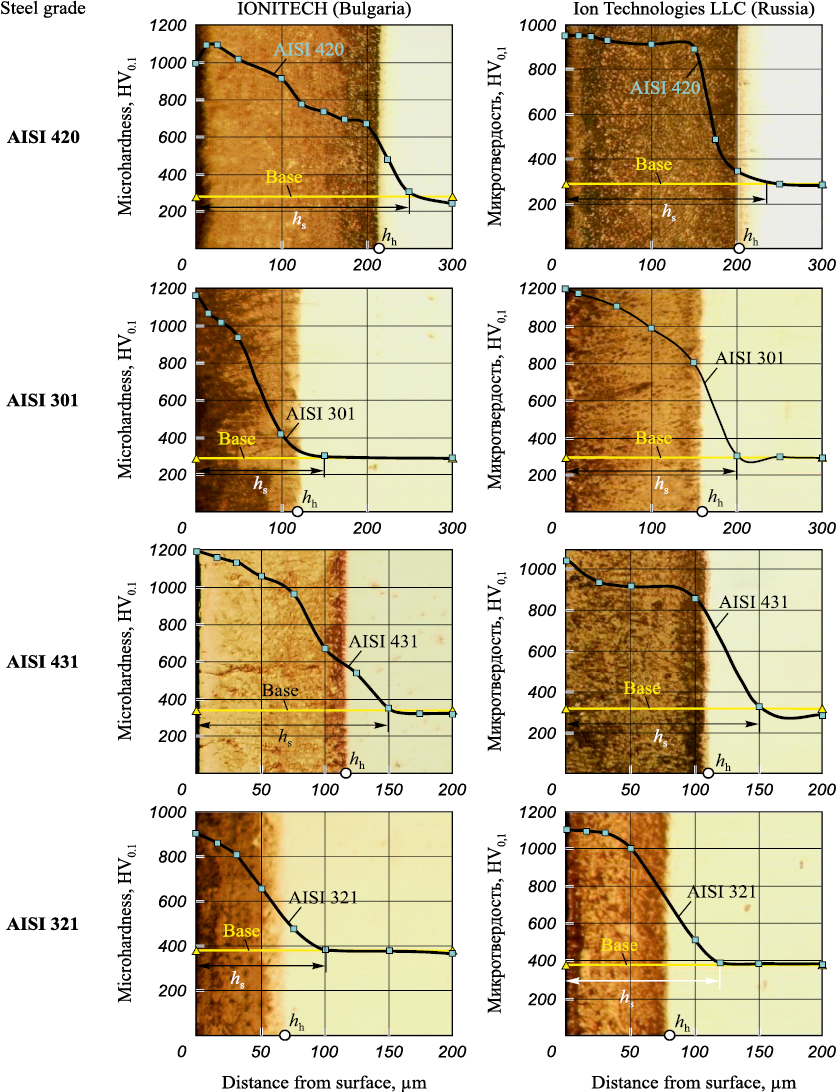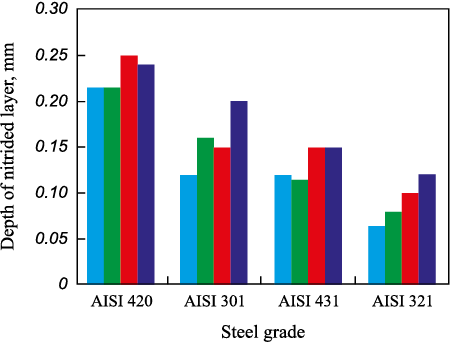Scroll to:
Surface modification of steels used in valve manufacturing
https://doi.org/10.17073/1997-308X-2024-4-83-90
Abstract
Shut-off and control valves are essential components in liquid and gas transportation systems; therefore, their reliable operation depends on the quality and properties of their surface parts. One method to enhance these properties is ion nitriding, which is actively used in Russia, Israel, Bulgaria, Belarus, Austria, and other countries. This method is easy to manage and control, is universal for all types of steels and alloys, is environmentally safe, ensures dimensional and surface finish accuracy, and improves the operational properties of parts. This paper presents summarized results of studies on the formation of modified layers on steels used in valve manufacturing. The steels of grades AISI 420, AISI 301, AISI 431, and AISI 321 were strengthened by ion nitriding. For the first time, comparative data obtained on equipment from different manufacturers are presented. A comprehensive metallographic analysis, durometric analysis, and hardness distribution assessment across the depth of the modified layer were conducted during the study. It was found that steels with more than 12 % Cr form a clearly defined diffusion layer, which appears dark after etching with a 4 % nitric acid solution. However, the overall depth of the layer, as assessed by the distribution of microhardness into the depth of the part, is 20–40 % greater than revealed by the microstructure. The surface microhardness after ion-plasma nitriding increased fivefold in the AISI 301 steel. Thus, strengthening parts of shut-off and control valves using this method addresses the issue of rapid surface wear. By modifying the surface, the operational properties of parts can be enhanced, ensuring the uninterrupted operation of the pipeline system.
Keywords
For citations:
Sokolova I.S., Oborin A.V., Porozova S.E. Surface modification of steels used in valve manufacturing. Powder Metallurgy аnd Functional Coatings (Izvestiya Vuzov. Poroshkovaya Metallurgiya i Funktsional'nye Pokrytiya). 2024;18(4):83-90. https://doi.org/10.17073/1997-308X-2024-4-83-90
Introduction
In many industrial sectors, the quality of pipes and especially shut-off and control valves (SCV) is critical not only for the uninterrupted transportation of liquids and gases but also for the overall accident-free operation of production facilities [1–4]. Protective coatings on the surface of metal and alloy products, obtained through ion chemical-thermal treatment (ICTT) methods, significantly improve their performance characteristics. One of the most promising variants of ICTT is ion nitriding [5–9]. The literature refers to this process by several names: ion-vacuum, ion-plasma, and ion nitriding [10–13]. This universal method of surface modification in a glow discharge plasma in a vacuum [14–16] is relatively simple to apply, allows for the strengthening of all types of steels and alloys, and is considered a “white metallurgy” process [17].
Engineers from the Israeli company “HABONIM” were among the first to apply low-temperature ion-plasma nitriding (IPN) to enhance the wear resistance of valve components [18]. Today, the technology of low-temperature plasma carbonitriding for ball valves is specified in all catalogs of the Israeli manufacturer [19].
Currently, the Austrians are recognized leaders in the field of ion nitriding. They have developed and patented technologies such as PLASNIT, PLASOX, and PLAPOL, which are also used to strengthen valve components [20].
Although research on the ICTT process has been conducted in Russia since the 1970s, the active use of ion nitriding in industry began relatively recently [21–24]. The production of equipment in Russia also started much later than in other countries, but today there are domestic IPN units available. Automated software based on technological know-how, the use of microprocessor and high-precision equipment, as well as technologies for high-speed transmission of large amounts of information and modular robotic systems, allows them to compete with foreign counterparts [21].
As of 2020, the share of imports in the consumption structure of industrial SCV in Russia was 53 % [3]. In 2023, it is still necessary to import the missing product positions [25], so domestic enterprises are independently mastering new types of products and seeking new technologies to improve the reliability and quality of valve products. In this regard, comparing results obtained on units from different manufacturers, as well as conducting research and summarizing data on the strengthening of steels by ICTT, are currently pressing tasks.
The aim of this work is to study the modified layers obtained by ion-plasma nitriding on steels used in valve construction and to compare the data obtained on Bulgarian and Russian production units.
Research methodology
The ion-plasma nitriding (IPN) process was conducted using equipment from IONITECH (Bulgaria) and Ion Technologies LLC (Russia). The IPN temperatures ranged from 550 to 580 °C, the pressure was 4 mbar, and the gas mixture consisted of 25 % N2 and 75 % H2 . The isothermal holding time (5–12 h) was determined based on the four different steel grades selected for the study. The holding duration was the same for identical samples on both setups. Fig. 1 shows images of parts during the nitriding process.
Fig. 1. View of parts “gate” (a) and “stem” (b) in plasma during the strengthening process |
The study was conducted on steels of grades AISI 431, AISI 420, AISI 301 and AISI 321, which are used for manufacturing SCV parts such as gates, seats, stems, separators, pistons, spindles, wedges, etc. The general characteristics of the steels are provided in Table 1. For destructive testing, witness samples were placed in the working chamber along with the parts.
Table 1. General characteristics of the investigated steels1
| ||||||||||||||||||||||||
After IPN, the entire surface of the samples was visually inspected for external defects. The nitrided surface was checked for color uniformity, and the absence of peeling and chipping, especially along sharp edges, at a magnification of 15–30 times. The brittleness of the nitrided layer was controlled by examining the diamond pyramid indentation according to the VIAM brittleness scale (STo INTI S.70.2-2022).
One of the key indicators of strengthening is surface hardness. This value represents the hardness of the thin modified layer, so it is important to select a load that ensures the indenter does not penetrate through the surface layer (STo INTI S.70.2-2022). Preparation for measuring this indicator involved smoothing the surface with P2500 grinding paper, after which the surface hardness of the layer was determined using the Vickers method according to GOST 2999-75 under a load of 49.03 N. Surface microhardness [26] was assessed under a load of 0.98 N according to GOST 9450-76 using a PMT-3 device (Russia).
Samples for microstructural analysis were embedded in Bakelite powder and prepared into slides according to the standard methodology (STo INTI S.70.2-2022). Microstructural examination was carried out using a BiOptic microscope (Russia) with a universal etchant (4 % nitric acid) to reveal the nitrided layer. According to standards, the total depth of the layer (hh ) is determined by measuring microhardness from the surface in a direction perpendicular to it until the microhardness matches the core microhardness value. The layer depth was controlled by the durometric method on a PMT-3 microhardness tester under a load of 0.98 N with a hold time of 10 s (STo INTI S.70.2-2022).
Results and discussion
The results of the study on nitrided layers on steels of different compositions (see Table 1), obtained using ion-plasma equipment from Bulgarian and domestic manufacturers, are presented in Fig. 2.
Fig. 2. Microstructures and microhardness distribution graphs by depth of nitrided layer |
Ion-plasma nitriding (IPN) resulted in a uniformly developed, non-brittle nitrided layer on the parts. Visual inspection showed that the parts and samples had a uniform matte gray color without any surface defects. Studies of steel sections with more than 12 % Cr content revealed a modified zone that is easily etched, with clear boundaries. The depth of the nitrided layers, as determined by microstructure, reaches hs = 0.08÷0.22 mm (Fig. 3), while the depth determined by microhardness distribution is hh = 0.10÷0.25 mm. In all cases, the depth hh of the nitrided layer obtained on the domestic equipment is greater.
Fig. 3. Histogram of the depth distribution of nitride layers |
For steels with martensitic and martensitic-ferritic structures (see Table 1), there are minimal differences in the depth of the nitrided layer between the microstructure and microhardness for layers obtained in both cases (Fig. 3), although the results using domestic equipment are higher. For austenitic-martensitic and austenitic steels (see Table 1), the differences in the depth of the nitrided layers are significant (Fig. 3), indicating that part of the nitrided layer (the transition zone) is not revealed by etching with the reagents used. Based on the obtained data, it can be concluded that the method of determining the depth of the nitrided layer by microhardness is more informative and accurate.
Table 2 presents the results of measuring the surface hardness and microhardness of the nitrided layers, which are the main criteria for the wear resistance of shut-off and control valves.
Table 2. Surface hardness and microhardness of nitride layers
| |||||||||||||||||||||||||||||||||||||||||
Modifying the metal surface led to an increase in the surface hardness of all the investigated steels. During the process of diffusion saturation of the surface with nitrogen, the formation of iron nitrides and alloying elements occurred, resulting in the increased hardness of the nitrided layer. The maximum result was observed in AISI 301 steel: its surface microhardness increased fivefold from ~260 HV0.1 to ~1200 HV0.1 . The minimum increase in microhardness (2.8 times) was noted in AISI 321 steel.
Thus, the surface hardening technology allowed for the preservation of the dimensional and surface finish accuracy of the parts [27]. Three of the largest Russian SCV manufacturers [3] are already using ion nitriding to improve the quality of their products and are incorporating it into their production cycles [28].
Conclusions
The commonly used steels in valve construction, AISI 420, AISI 301, AISI 431 and AISI 321, show an increase in surface hardness by 2.8 to 5 times after ion-plasma nitriding under the conditions of the conducted studies.
The method of assessing the depth of the nitrided layer by microhardness is more accurate than determining it by microstructure. This is because, during the nitriding of austenitic-martensitic and austenitic steels (see Table 1, Fig. 3), part of this layer (the transition zone) is not revealed by etching.
A comparative analysis of the microhardness of the modified layers established that the Russian equipment produced by Ion Technologies LLC performs on par with foreign equipment under identical operating conditions. It demonstrates comparable surface hardening results for parts to those achieved with well-known global market equipment from IONITECH (Bulgaria).
References
1. Afanas’eva O.V., Korkunov S.B., Ter-Mateosyants I.T. Trends in the development of the Russian market of pipeline valves in 2015. Under the conditions of sanctions and counter-sanctions. Territoriya Neftegaz. 2016;6: 96–99. (In Russ.).
2. Kolotyrin E.A. Importsubstitution in the Russian valveindustry. Internet-zhurnal «Naukovedenie». 2016;8(3): 1–17. (In Russ.). https://doi.org/10.15862/40EVN316
3. The market of shut-off and control valves during the crisis of 2020. Promyshlennik Sibiri: otraslevoj zhurnal. URL: https://prom-siberia.ru/analytics/analiz-rynka-zapornoj-armatury-v-usloviyah-krizisa-2020-goda/ (date of access: 03/02/2023). (In Russ.).
4. Kazantsev M.N., Flegentov I.A., Petelin A.N. Ways to improve the reliability of shut-off valves for trunk pipelines (on the example of gate valves). Neftegazovoe delo. Transportirovka, hranenie nefti i gaza. 2016;14(4):75–81.(In Russ.). https://doi.org/10.17122/ngdelo-2016-4-75-81
5. Gerasimov S.A., Kuksenova L.I., Lapteva V.G. Structure and wear resistance of nitrided structural steels and alloys. Moscow: MGTU imeni Baumana, 2014. 520 p. (In Russ.).
6. Bhadraiah D., Nouveau C., Ram Mohan Rao K. Plasma nitriding of CrMoV steel for the enhancement of hardness and corrosion resistance. Transactions of the Indian Institute of Metals. 2021;75(2):371–380. https://doi.org/10.1007/s12666-021-02423-2ff
7. Landgraf P., Bergelt T., Rymer L.-M., Kipp C., Grund T., Bräuer G., Lampke T. Evolution of microstructure and hardness of the nitrided zone during plasma nitriding of high-alloy tool steel. Metals. 2022;12(5):866. https://doi.org/10.3390/met12050866
8. Ram Mohan Rao K., Nouveau C., Khanna A.S., Karanveer S. Aneja, Trinadh K. Plasma nitriding of 90CrMoV8 tool steel for the enhancement of corrosion resistance. Materials Today: Proceedings. 2020;24(2):1006–1010. https://doi.org/10.1016/j.matpr.2020.04.413
9. Carrivain O., Hugon R., Marcos G., Noel C., Skiba O., Czerwiec T. Inspection of contamination in nitrogen plasmas by monitoring the temporal evolution of the UV bands of NO-γ and of the fourth positive system of N2 . Journal of Applied Physics. 2021;130(17):173304. https://doi.org/10.1063/5.0064704
10. Pye D. Practical nitriding and ferritic nitrocarburizing. ASM International, 2003. 256 p. https://doi.org/10.1361/pnafn2003_FM
11. Ram Mohan Rao K., Trinadh K., Nouveau C. Glow discharge plasma nitriding of low alloy steel. Materials Today: Proceedings. 2019;19:864-866. https://doi.org/10.1016/j.matpr.2019.08.224
12. Chemkhi M., Retraint D., Roos A., Garnier C., Waltz L., Demangel C., Proust G. The effect of surface mechanical attrition treatment on low temperature plasma nitriding of an austenitic stainless steel. Surface & Coatings Technology. 2013;221:191–195. https://doi.org/10.1016/J.SURFCOAT.2013.01.047
13. Trinadh K., Nouveau C., Ram Mohan Rao K. Effects of plasma nitriding on low alloy Cr–Mo–V steel. Materials Today: Proceedings. 2021;40(1):79–82. https://doi.org/10.1016/j.matpr.2020.03.720
14. Cabeça M.C.S., Rodrigues S.F., Neto A.S., de Miranda-junior E.J.P., Reis G.S., de Oliveira A.M. Comparative study on plasma nitriding in cathodic cage with conventional Nitriding of the austenitic stainless steel 316. International Journal of Current Research. 2017;9(01):44666–44672.
15. Okan Unal, Erfan Maleki, Remzi Varol. Effect of severe shot peening and ultra-low temperature plasma nitriding on Ti–6Al–4V alloy. Vacuum. 2018;150:69–78. https://doi.org/10.1016/j.vacuum.2018.01.027
16. Forati Rad H., Amadeh A., Moradi H. Wear assessment of plasma nitrided AISIH11 steel. Materials & Design. 2011;32(5):2635–2643. https://doi.org/10.1016/j.matdes.2011.01.027
17. Tazetdinov V.I. “White metallurgy” as a tool for improving the efficiency of innovative development of pipe production. Mezhdunarodnyi zhurnal prikladnykh i fundamental’nykh issledovanii. 2011;(12):52–55. (In Russ.).
18. Ramon J., Botstein O., Jaccod G. Plasma nitriding of 316L stainless steel at low temperature will significantly increase the wear resistance of the reinforcement: Mater. of 6th International Exhibition and Conference “Valve World 2008” (Maastriht, 4–6.11.2008). Armaturostroenie. 2010.67(4):27–28. (In Russ.).
19. Habonim product catalog. Ball valves with metal seats. 2017. No. 48. URL: www.habonim.com (accessed: 13.02.2023).
20. RUBIG Driving Success [Electronic resource]. URL: https://www.rubig.com (accessed: 13.02.2023).
21. Oborin A.V., Bogdanov V.V. Progressive technology of hardening of critical products of the oil and gas industry. A brief history. The present moment. The prospects. Neft’. Gaz. Metalloobrabotka. 2018;67(7):48–50. (In Russ.).
22. Kachenyuk M.N., Noskov A.V., Patrushev V.S. Investigation of the influence of various modes of ion nitriding on the formation of a surface hardened layer of high-speed steel R6M5. Molodoj uchenyj. 2016,23(127):50–54. URL: https://moluch.ru/archive/127/35139/ (accessed: 21.08.2023). (In Russ.).
23. Spivak L.V., Shchepina N.E., Bogdanov V.V., Oborin A.V., Soldatkin L.N. Calorimetry of phase transformations of the nitrided layer in nitralloy. Fundamental’nye problemy sovremennogo materialovedeniya. 2021;18(2):210–215. (In Russ.). https://doi.org/10.25712/ASTU.1811-1416.2021.02.009
24. Gazizov A.Z., Dumler E.B., Saracheva D. A. Method of increasing the strength properties of the elements of shut-off valves. In: The role of mathematics in the formation of a specialist: Materials of the International Scientific and Practical Conference (Ufa, May 18, 2021). Ufa: USNTU, 2021. P. 105–110. (In Russ.).
25. Moritz M. Sanctioned Imports: white, grey, parallel. ARMTORG Media Group. 02.22.2023. URL: https://armtorg.ru/news/46145/ (accessed: 03.02.2023). (In Russ.).
26. Sommer M., Ebner G., Decho H., Hoja S., Fechte-Heinen R. Surface preparation for characterization of nitride compound layers using hardness indentation and the Palmqvist method. Journal of Materials Research and Technology. 2023;24(3):7974–7988. https://doi.org/10.1016/j.jmrt.2023.05.041
27. Bosyakov M.N., Silina O.V., Kozlov A.A. Plasma chemical-thermal treatment. Perm: PNIPU, 2023. 135 p. (In Russ.).
28. Implemented equipment. URL: https://www.procion.ru/vnedrenie_tehnologii_xto/vnedrennoe_oborudovanie/ (accessed: 05.04.2023). (In Russ.).
About the Authors
I. S. SokolovaRussian Federation
Irina S. Sokolova – Postgraduate student at the Department of “Mechanics of Composite Materials and Structures” (MCMS), Perm National Research Polytechnic University (PNRPU), Head of Laboratory at Ion Technologies LLC
29 Komsomolskiy Prosp., Perm 614990, Russia
47A Bld. 5 Shosseinaya Str., Krasnokamsk 617064, Russia
A. V. Oborin
Russian Federation
Aleksei V. Oborin – Director
47A Bld. 5 Shosseinaya Str., Krasnokamsk 617064, Russia
S. E. Porozova
Russian Federation
Svetlana E. Porozova – Dr. Sci. (Eng.), Professor at the Department of MCMS
29 Komsomolskiy Prosp., Perm 614990, Russia
Review
For citations:
Sokolova I.S., Oborin A.V., Porozova S.E. Surface modification of steels used in valve manufacturing. Powder Metallurgy аnd Functional Coatings (Izvestiya Vuzov. Poroshkovaya Metallurgiya i Funktsional'nye Pokrytiya). 2024;18(4):83-90. https://doi.org/10.17073/1997-308X-2024-4-83-90




































